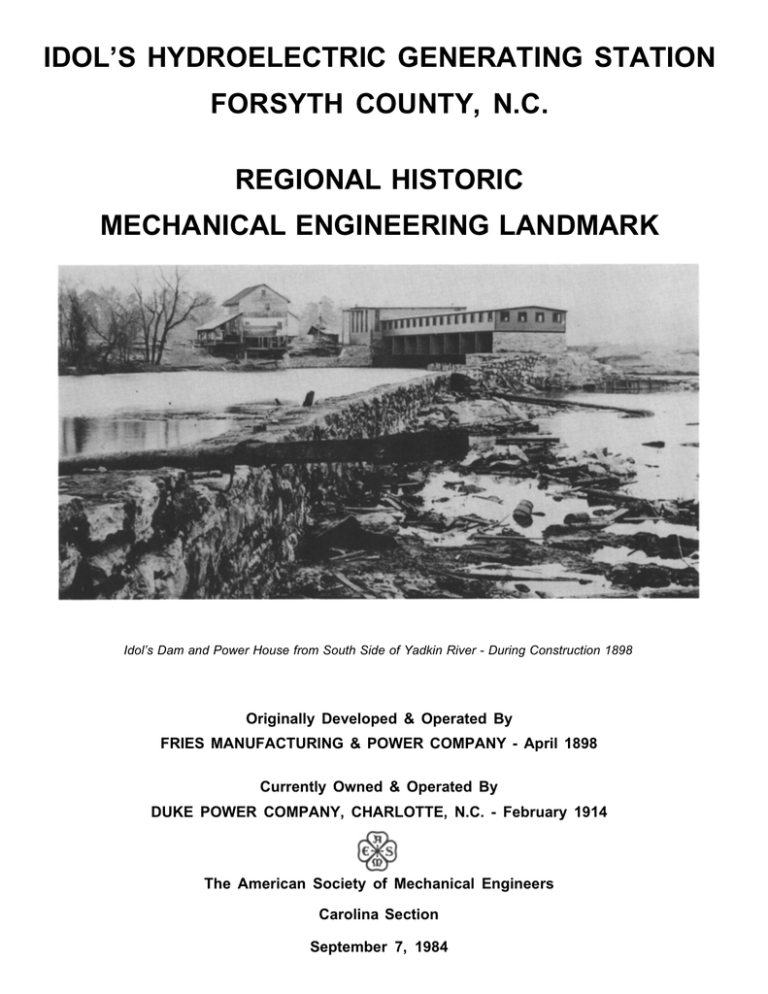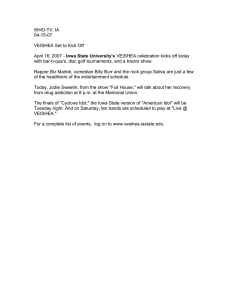idol`s hydroelectric generating station forsyth county, nc regional
advertisement

IDOL’S HYDROELECTRIC GENERATING STATION FORSYTH COUNTY, N.C. REGIONAL HISTORIC MECHANICAL ENGINEERING LANDMARK Idol’s Dam and Power House from South Side of Yadkin River - During Construction 1898 Originally Developed & Operated By FRIES MANUFACTURING & POWER COMPANY - April 1898 Currently Owned & Operated By DUKE POWER COMPANY, CHARLOTTE, N.C. - February 1914 The American Society of Mechanical Engineers Carolina Section September 7, 1984 HISTORIC SIGNIFICANCE OF IDOL’S HYDRO were designed to provide 2,000 horsepower with initial generating equipment installed for 1,000 horsepower. Idol’s Hydro Station, as developed and placed in operation by The Fries Manufacturing and Power Company on April 18, 1898, was typical of small-scale, low-head first generation hydroelectric stations of that day. It was the first commercial hydroelectric generating station in North Carolina using long distance (13¼ miles) transmission of alternating current power at 10,000 volts. It provided power for textile and fertilizer mills, an electric railway system, electric street lighting, and wood and metal working shops in the towns of Winston and Salem, N.C. The availability of electric power generated at Idol’s Station enabled the early development of the Winston-Salem area as a significant industrial and manufacturing center in North Carolina. Although its generating machinery was replaced in 1914, the facility’s operation has changed little since the turn of the century. The first field surveys began in February 1897 and investors purchased $50,000 of the original $60,000 of capital stock issued by Fries Manufacturing and Power Company by the following April. The firms supplying machinery for the plant also invested in the project, as did electrical inventors Thomas A. Edison and Frank J. Sprague. ORIGINAL PLANT CONSTRUCTION Construction began in early June 1897 with Watkins & Hardaway of Birmingham, Alabama, performing the masonry work on the dam and powerhouse. J. C. Bachelor of Winston-Salem received the construction contract for a 600 ft. rail siding connecting the construction site to the Southern Railway tracks which allowed heavy equipment and machinery to be delivered directly to the site. Throughout the summer the weather was good, the river was low, and the work progressed rapidly. Former North Carolina Lt. Governor Charles A. Reynolds served as chief engineer for the project. Many of the workers lived in a construction camp at the site. PRE-CONSTRUCTION HISTORY AND DEVELOPMENT The development of Idol’s Hydro Station was initiated by Henry Elias Fries of Winston-Salem, NC. At the time, Mr. Fries was involved with the ownership and management of several textile mills and a grain mill. As a result, he developed a keen interest in the use of electricity to power industrial machinery in the 1880’s. He was the president and guiding force behind the February 28, 1891 chartering of the Fries Manufacturing and Power Company which proposed harnessing the hydroelectric capability of Douthit’s shoals on the Yadkin River. While on a trip to New York in 1896 to honor former President Grover Cleveland, he engaged an electrical engineer in a discussion of the feasibility of long distance transmission of electric power. This resulted in his wiring Winston-Salem to obtain approval to use his uncle’s, Henry W. Fries, Douthit Mill site and to proceed with the development of the facility design. He engaged C. R. Makepeace and Company, Mill Engineers and Architects, and Lewis and Claflin, Electrical Engineers, both of Providence, R.I. to provide the design. Makepeace, a native North Carolinian familiar with the area, prepared the mechanical and building plans while Lewis and Claflin designed the electrical installation and transmission system. Figure 2 - Idol’s Hydro Powerhouse and Tailrace Area - 1898 The 482 ft., rubble-masonry, curved gravity dam, was built on stone foundations, stood 10 ft. tall, stepped to 13 ft. at both ends. A 4 ft. wide, stone-baffled, inclined sluiceway fishladder was incorporated into the downstream face of the dam. The dam height was reduced to 9½ ft. for a 6 ft. length where the ladder reached the top of the dam to allow passage of water on normal and high flow. The crest of the dam measured 6 ft. in width and the base was 12 ft. The granite stone for the dam and the powerhouse foundation was quarried at the site. When filled, the reservoir had a surface area of approximately 35 acres with 6 miles of shoreline (see the frontpiece picture). The Idol’s Hydroelectric Station received its name from its location at a former Yadkin River ferry crossing known as Idol’s. It was designed as a run-of-the-river plant to prevent the flooding of the low lying area above the site that a high dam would cause. Therefore, the dam could store only a small amount of hydraulic power and only the irregular flow of the river could be used. This flow provided an estimated 2,000 to 2,700 horsepower with a yearly average of 2,300 horsepower at a 10 ft. head. The dam and powerhouse 2 Figure 4- 150 Ft. Generator Drive Shaft and Bevel Gearing from Turbines - 1898 Figure 3 - 54” Diameter McCormick Vertical Geartype Turbine Figure 5 - One of Eight Turbine Bevel Gear Drives to Generator - 1898 The Powerhouse consisted of a turbine or wheel room and a generator room at right angles to each other on the north bank of the Yadkin. The wheel room formed one end of the dam into which it was built and measured 145 ft. x 36 ft. It was divided into eight wheel pits which were constructed of rough stone. The downstream face of the pits had arched openings which emptied into the tailrace (see figure 2 on page 2). The foundations extended 4 ft. down into the rock of the riverbed. The division walls of the wheel pits were 24 in. thick, composed of brick, and served as foundations for the heavy timber construction of the wheel room. The walls also supported the 10 in. x 15 in. beams upon which the machinery of the wheel room rested. The exterior face of the wheel room consisted of 4 in. wide planking and a standing-seam metal roof covered the structure. Each wheel pit was designed to be equipped with two turbines with a 2 ft. x 12 ft. waste gate between them. At the entrance of the wheel pits a steel trash rack kept floating debris out of the turbines. The rack extended across the upstream face of the wheel pits for 144 ft. The plant’s generator room was a single story brick structure located at the north end of the wheel room. This building measured 39 ft. x 60 ft. and had a heavy timber frame with an 18 ft. ceiling height. The initial machinery installation consisted of eight turbines, one in each pit. They were of the McCormick vertical gear type, 54-inch diameter, manufactured by S. Morgan Smith Co. of York, Pa., and designed to deliver 165 horsepower each when running under 9 ft. of head (see figure 3 above). They were submerged and were mounted on a 6 in. floor supported on l-beams 8 ft. below head water. The draft tubes discharging from the turbines pass through the floor and extend to the tailrace 2 ft. below. The generator drive system connected eight turbines through bevel gearing to a 7½ in. diameter x 150 ft. long horizontal drive shaft to supply motive power to the generator through a flexible insulated coupling. The horizontal drive shaft was mounted on bearings supported by the wheel pit division walls. The vertical shaft from each turbine carried a large bevel gear with hardwood teeth which meshed with an iron bevel gear on the drive shaft (see figures 4 and 5 above). The drive shaft consisted of two sections, each driven by four turbines. By means of a coupling, four or eight turbines could be used. The system was governed by two Lombard Type B hydraulic governors, one for each set of four turbines. Each governor controlled 3 A lightning protection rack hung above the switchboard in three vertical sections, each carrying a set of arrestors and choke coil for each leg of the high-voltage circuit. only three turbines in each set with the fourth being controlled manually. The hydraulic governors actuated a series of gears which opened and closed each turbine’s gates. The station wiring ran beneath the floor. The high-voltage wires were insultated for 25,000 volts and supported on triple-petticoated porcelain insulators on horizontal cross bars. They entered the switchboard by passing through the floor at the base of the pillar. The three outgoing high-voltage power lines left through the top of the pillar and connected with the transmission lines running into Winston and Salem. Throughout the plant, the S.K.C. system of electrical machinery (a brand name for the Stanley Electric Manufacturing Company of Pittsfield, Mass.) was used. The generator, a three-phase induction type with an output of 750 KW at 166 rpm, was wound to deliver 10,000 volts to the line without use of step-up transformers. The efficiency of this machine was claimed to be 93.5%. The generator stood 10 ft-1 in. tall, weighed about 30 tons, and was divided horizontally to allow access to the armature and field windings for repairs. The machine was mounted on a pit foundation, extending to bed rock, and the pit was thoroughly grouted and plastered to keep out any high water (see figure 6 below). TRANSMISSION LINES, SALEM SUBSTATION, AND CUSTOMER CIRCUITS In October, 1897, crews began erecting the poles for the 13¼ mile long transmission line to the Salem substation. Figure 6 - Little Marguerite Fries Formally Starting Idol’s Generator on April 18, 1898 Figure 7 - Construction Workers and Sunday Visitors at Idol’s During Final Days of Construction - 1898 A 14 KW, four-pole Cracker-Wheeler machine, driven at 1,100 rpm by the generator drive shaft system, served as the generator field exciter. It delivered current at 70 volts and was large enough to excite the fields of two generators of the type installed. White cedar poles measuring 36 ft. and 48 ft. in height were used and 5½ ft. to 6 ft. of the poles were sunk in the ground. The poles were spaced 100 ft. apart, except at roadway crossings where they were only 50 ft. apart. Each pole carried three cross bars with the lower two carrying the power circuit. That circuit consisted of three No. 1 softdrawn, bare copper wires strung on No. 1 Imperial porcelain insulators which were 6 in. tall and triple-petticoated. The power lines, spaced 24 in. apart, formed an equilateral triangle with the lower cross bar carrying two wires. All of the initial power lines were on one side of the pole, leaving the other side open for a future circuit. To overcome problems caused by induction between the lines, the triangle was twice rotated 1200, thus giving the triangle twothirds of a rotation enroute to Salem. The top arm had six pins with the outer pair carrying an iron, barbed-wire ground circuit. Every 1000 ft. this line was brought to ground The switchboard, located in the generator room, consisted of four white marble slabs forming a 21 in. square pillar 9½ ft. tall with all live contacts within the pillar. Three highvoltage, single-pole, single-throw switches were mounted on the board. They were of the plug type with long handles and a bayonet lock. The board also contained a generator volt-meter and AC ammeter along with a voltmeter and switch for the exciter circuit and the exciter field rheostat. The generator field rheostat was suspended 18 inches below the floor for space and ventilation reasons and was controlled by a handle through the floor. 4 Figure 9 - Allis Chalmers Generators Installed in 1914 are in Operation Today Figure 8 - Managers and Operating Personnel at Idol’s Powerhouse Doorway - 1907 IDOL’S OPERATING STAFF through a ½ in. galvanized pipe driven 10 ft. into the ground at the base of the pole. The inner pins carried a telephone circuit, which could be grounded in case of a storm. Every mile a branch of the telephone circuit was brought down a pole to within a few feet of the ground to allow communications with either end of the circuit. The extra pins on the crossbar were used to transpose the telephone circuit every 500 ft. The Idol’s operating staff worked 12-hour shifts with about six men on each shift. The crews’ primary responsibility was to clean debris from the trash racks with long-handled rakes. At times they manned the rakes for 36 hours straight (see figure 8 above). The lines entered the Salem substation on the second floor, with proper lightning protection, and passed to the main bus bars on the first floor. With proper switches and transformation, the lines were carried to the various service points in Winston and Salem. They included: (1) Southern Chemical Co. (fertilizer works), (2) Southside Cotton Mill (textiles), (3) Winston-Salem Railway and Electric Co. (street railway and lighting), (4) Fogle Brothers Shop (wood working), (5) J. A. Vance Shop (metal working), and (6) Arista Mill (textiles). IDOL’S EXPANSION AND CHANGES IN OWNERSHIP With the plant operating at full capacity shortly after it opened, plans were quickly made to incorporate the second line of eight turbines and their generator into the system. the precise date of this installation is unknown, but it is believed to have occurred around 1903. On June 25, 1913 Fries Mfg. and Power Co. was absorbed by the Southern Public Utility Co., a forerunner of Duke Power Co. and continued to provide power to the mills and shops of Winston-Salem. CUSTOMER POWER COST AND PLANT COST Power was sold to customers by meter at a minimum charge of 25 horsepower per year. For a 12-hour day the rate was $20.00 per horsepower per year, while for a 24-hour day the rate was $40 per horsepower per year. Duke Power Co. took over the operation in February 1914. They replaced the original machinery with six Allis Chalmers vertical, 54 inch, Francis-type turbines each of which generate 300 horsepower and six Allis Chalmers 2,300 volt, 74 amp, 90 rpm, three-phase generators mounted directly above each turbine. Each generator had its own switchboard and the new main switchboard and exciter were mounted in the wheel room. The generator room was converted to a transformer room for step-up transformers to increase line voltage for transmission to the Duke system. Five units of this machinery, with some minor improvements and modifications, remain in use today (see figure 9 above). Shortly after the plant opened the Yadkin River flooded, causing Fries Mfg. and Power Co. to spend $30,000 to lengthen the dam and increase protection of the powerhouse. These additions raised the cost of the plant to $155,000. Floods did not deter sightseers, who crowded the roads to the site for months for see the new facility (see figure 7 on page 4). 5 ABOUT ASME LANDMARKS The Carolina Section of ASME Idol’s Hydroelectric Generating Station is the eighth Regional Mechanical Engineering Landmark to be designated since the program began in 1973. Since then sixteen International and seventy-one National Landmarks have been recognized by the Society. Each represents a progressive step in the evolution of mechanical engineering and each reflects its influence on mankind. J. Ron Weston, Chairman M. Keith Farris, Vice-President Houston M. Smith, Secretary David W. Newsome, Treasurer William B. Crane, Chairman — History and Heritage Committee The Landmarks Program recognizes our technological heritage and serves to encourage the preservation of the physical remains of historically important works. It provides an annotated roster for engineers, students, educators, historians, and travelers and helps establish persistent reminders of where we have been, where we are, and where we are going along the divergent paths of discovery. REGIONAL LANDMARKS • • • The Carolina Section gratefully acknowledges the efforts of all who participated in the Landmark designation of Idol’s Hydro, particularly: (1 ) Dr. Patrick W. O’Bannon, Historian and the Historic American Engineering Record of the National Park Service whose report provided the basis for the nomination; (2) “American Electrician,” Vol. X, No. 10, Oct. 1898 (figure 3); Bill East, City Editor, “Twin City Sentinel” (frontpiece and figures 8 and 9); and Old Salem, Inc. (figures 2, 4, 5, 6, and 7); who provided photographs of Idol’s facilities and equipment from their files; and (3) Duke Power Co., whose information & staff cooperation, assistance, and approval made the nomination possible. • • • • • Paige Compositor (1877) Hartford, Conn. — designated 1975 Allis Chalmers Water Pump Driven by Corliss Steam Engine (1917) Jacksonville, Fla. — designated 1976 Chestnut Street Pumping Station Steam Engine (1913) Erie, Pa. — designated 1980. Grave Mill (1852) Hensdale, Ill. — designated 1980 Corliss Cross-Compound Pumping Engine (1925) York, Pa. — designated 1982 Reed Gold Mine Stamp Mill (1895) Cabarrus County, N. C. — designated 1983 Archimedes Wind-Powered Screw Pump (1890) San Mateo, Ca. — designated 1984 Idol’s Hydroelectric Generating Station (1898) Forsyth County, N. C. — designated 1984 REGIONAL HISTORIC MECHANICAL ENGINEERING LANDMARK IDOL’S HYDROELECTRIC GENERATING STATION The American Society of Mechanical Engineers 1898 FORSYTH COUNTY, NORTH CAROLINA George Kotnick, P. E. — President Dr. Theodore G. Brna — Vice-President, Region IV Sylvan Cromer — Chairman, History and Heritage Committee, Region IV This run-of-the-river plant is an excellent example of late nineteenth century small-scale (750 KW) low-head hydroelectric power technology. The Idol’s Station was the first commercial hydroelectric plant in N. C. involving long distance power transmission and Idol’s was an important power source for transportation, lighting and industry in the Winston-Salem area, 14 miles distant. The original 1898 equipment was replaced in 1914 and the facility continues to serve the people of this region. The ASME National History and Heritage Committee Dr. R. Carson Dalzell — Chairman Robert M. Vogel — Sec. (Curator, Smithsonian Inst.) Dr. Robert B. Gaither, (Mech. Engrg. Dept., Univ. of Fla.) Prof. Richard S. Hartenberg, (Mech. Engrg. Dept., Northwestern Univ. Tech. Inst.) Dr. J. Paul Hartman, (College of Engineering, Univ. of Central Fla.) Dr. Merritt Roe Smith, (Massachusetts Institute of Technology) THE AMERICAN SOCIETY OF MECHANICAL ENGINEERS CAROLINA SECTION 1984 Figure 10 - Idol’s Landmark Plaque 6 H099


